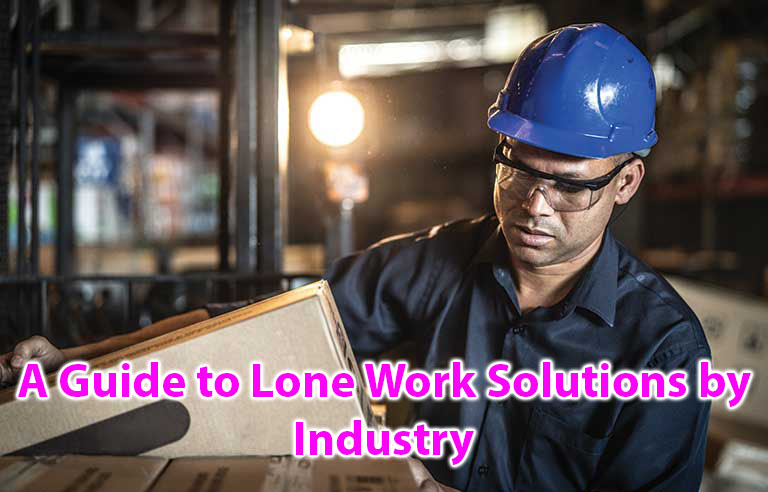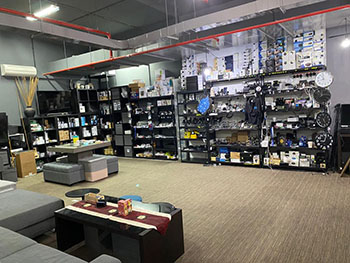A Guide to Lone Work Solutions by Industry (A10005)
 Lone workers in different industries face diverse risks, it is among the duties of the employer to protect them by ensuring their safety no matter what it is they are doing. Risks usually common while working alone could range from falls to burns or even crashes at a site. Hence risk assessment is very necessary, companies must access situations where they are working and know the possible risks their workers might undergo and then get solutions to them. Using technology in recent times has become a factor that has grown the population of lone workers. It is suddenly a believe there is a device they can rely on that could guarantee their safety and relay SOS messages in an automated manner if anything were to happen. We would be looking at some industries, the risks they face and the solutions that have a very high chance of changing things. The industries are:
Lone workers in different industries face diverse risks, it is among the duties of the employer to protect them by ensuring their safety no matter what it is they are doing. Risks usually common while working alone could range from falls to burns or even crashes at a site. Hence risk assessment is very necessary, companies must access situations where they are working and know the possible risks their workers might undergo and then get solutions to them. Using technology in recent times has become a factor that has grown the population of lone workers. It is suddenly a believe there is a device they can rely on that could guarantee their safety and relay SOS messages in an automated manner if anything were to happen. We would be looking at some industries, the risks they face and the solutions that have a very high chance of changing things. The industries are:
- Agricultural industries: lone workers at the agriculture sectors are either working with animals or operating machinery, workers in this field are prone to many risks as they work. In the UK agriculture has 18 times higher than other sectors fatal injury cases. The health challenges faced by these lone workers are however not to be ignored. There are many risks that are faced by workers on the farm, these risks are generated from doing jobs like working on the field with heavy vehicles and also moving materials by hand. According to a health safety report in the UK people dealing with animals are at high risk of getting injured. These risks could include. Some risks involved are:
- Falls from a height could result in injuries that are fatal, being trapped by collapsing equipment or logs resulted in a further 3 deaths in 2017 in the UK. A similar thing could happen anywhere in the world.
- Injuries are sustained a lot when working with animals, working with cattle was the biggest farm killer in 2017. It accounted for 33 fatalities.
- Moving tractors could hit workers and eventually injure or kill them. There is also a huge risk for those driving safety concerns around moving vehicles is important.
These problems must be checked and addressed while creating solutions to protect workers safety, conducting regular training can be very useful. Seasonal changes must be paid attention to, there should be updates to animal handling and equipment used. Machinery and equipment with vehicles must be well maintained and serviced, protective clothing must also be provided. All tasks must be well considered if they’ll require supervision or pairing up in a buddy system to get the job done. Also, ensure that monitor and check-in systems are working perfectly well. Most importantly use a lone worker safety solution that makes the process easy and effective. The best to rely on would be technology.
- Mining industry: whoever owns or manages a mine is in charge of ensuring that the risks associated with any individual working alone is completely evaluated. Measures to ensure control of situation is also implemented, while working underground there is a legislative for workers working alone to be inspected and regularly visited at least every 2 hours. Depending on the hazardous nature of working in a place alone, then no work should be alone and when working with others must always remain in their line of sight. While working at a mine it is important you comply with the laws abiding the country or state mining rules. Some risks of working at a mine are:
- Coal dusts: these dust could be very harmful and knock out a worker in minutes
- Collapse of tunnel
- UV exposure
- Thermal stress
- Chemical hazards
While working at the mines, the supervisors should ensure that:
- There are all aware of the high risks hazards and that all communication is being adhered to
- All measures practices must be taken to control hazards and minimize the risk associated with work
- They must be familiar with the appropriate safety equipment and its location.
When a worker is down it is essential he gets attention as soon as possible. There are to be measures put in place to reduce time between an accident and medical attention. Some of these measures are:
- Video surveillance cameras should be used
- Lone workers must frequently make contact with other workers in the mine
- A two-way radio communication device should be used
- A private duress alarm system can be used.
- Construction industry: workers in the construction face a particularly unique problem of social and environmental risks, this includes robbery and also on site injuries. There is a sub sector of the construction work that requires lone working or having to work in small groups and it includes tasks such as: building new things, making alterations to already made buildings or even performing maintenance on an existing structure. Those in construction work are often involved in working far above the ground elevation and this could be quite dangerous. Working with heavy equipment and machinery also put them at substantial environmental risk. According to the bureau of labor statistics the US; falls, slips or trips caused 699 workers fatalities in 2013. Additionally, the same report stated that in that same year 717 work fatalities resulted from contact with a sharp object. Lone workers do their own projects with no one around to supervise them or even notify them if anything goes wrong. There are four events that lead to workers death at construction sites. They are named as the fatal four, they are:
- Electrocution (about 9%)
- Being struck by an object (over 10%)
- Falls (over 36%)
- Being caught between industry equipment (2.5%)
While these employees face a greater environmental risk than most other industry, they are not limited to this type of risk. Due to the lone nature of their job and odd hours of working they also face social risks. They need to pay close attention to their environment and everything happening around them too.
Due to the nature of the job done by a lone worker, it is important that they have a very good worker solution that could help remove the risks these jobs come with. Some devices that can be utilized by the management are:
- Ensuring employees wear correct protective gears
- Health and safety training
- Clear display signs
- Correctly constructing and maintaining scaffolding
- Inspection of tools and equipment regularly
- Fall sensors
- Safe Check system: this means that a guard checks in at regular intervals by responding to automated prompt
- SOS tools: this could be used to send an alarm when a worker is being harassed while on site
- Manufacturing industries: this industry performs the role of converting raw materials to valuable products, teams work in about 20 subsectors which includes paper, plastic, food, electronics and biotech & pharma. To get a job done you employees need to spend long hours of work with heavy duty equipment in performing production activities. Ensuring the health of workers in this industry is very important, these workers are the most important asset to any industry. According to the bureau of labor statistics in the United States, this particular industry reports more than 300 work causalities yearly. Also in 2013 and 2014 according to the health safety executives manufacturing industry accounted for about 10% of fatalities of the British workforce in the UK. Thousands of workers annually have accidents that make them permanently disabled, many of which are unable to work for life. The ability to send a quick emergency response can reduce the suffering of lone workers waiting for help and reduce the impact of long-term injury. Some work setting such as chemical plants presents more dangers than others. The threat of chemical spilling and the exposure adds to the urgency of an effective lone worker safety policy. Employees must ensure that anyone working alone with heavy equipment has proper protection.
To protect lone workers health, it is first important that the company first identify all the lone workers working under them before instituting policies to safeguard their health. This enables them know which safety standards need to be used, managers aren’t always aware of those working with them or those working with a close by the team. Identification of aspects that might increase vulnerability is important. Conducting a risk assessment is very imperative as it allows you to know what risk is being faced and helps you match it with the right approach. Lone workers safety policy is also very important to have since it takes risks identified into consideration. Lone workers should use the latest technology solutions for their jobs. Manufacturing industries should be fitted with a telecommunications device that would allow a quick response when there is an incident. Lone workers in the manufacturing industries face more risks than the group workers, it is very important the industry has a good policy and also a working lone worker solution.
- Electricity: working with electricity can be very dangerous, workers at an electricity distribution industry face the risk of being electrocuted if they touch power lines carelessly or contact a grid system. Carrying maintenance on a remote site power system can also be a dangerous job too. When working alone there is that large chance of being in danger this is due to the high risks of hazards posed by the electricity industry, receiving aid and help also becomes a very hard task since the workers are inaccessible. Many times receiving immediate support or medical help could literally be the difference between a life changing minor and fatal injury. Some risks faced are:
- Faults in line which could cause a flame
- Contacts with life wire that could cause shock and burns
- Fire or explosion where electricity could be the source of ignition in a potentially flammable or explosive atmosphere.
As an employer, it becomes your duty to ensure some of the following is done to ensure lives are safe. They are:
- All electrically powered equipment is suitable for use
- The correct cable connector or coupler must be used to join a length of cable to together, the taped joint must be avoided they often result in sparks
- The socket-outlet must not be overloaded by the use of adaptors
- Oil and gas industry: The oil industry like the electricity industry requires keen attention also and the lone workers safety must be ensured, when inspecting pipelines and leakages there are dangers. Sprain and strain are among the most common types of injuries suffered by employees in the oil and gas sector. Some of the risks suffered while working in the oil and gas sector are:
- Hydrocarbon release(this can be very harmful and dangerous)
- Fire or a sudden explosion
- Dropping of large and heavy objects
These risks mentioned above could cause major injury or even death in some cases, if a worker is alone it makes it worse since they can suffer fatal injury if not quickly attended to. The lone workers are the ones faced with the most dangerous of duty, they face hazards like slips, trips, falls, cuts and even get exposed to very toxic and flammable gases. Most oil refineries, offshore rigs, and even factories are also considered as explosive hazardous areas. These areas are often filled with flammable gases, mists, dust, liquids or vapors that could cause huge explosions. By all these, it becomes quite imperative that the organization has to use some technological devices like the iHelp that would help with two-way communication that doubles as tracker and also has fall detectors. The company should ensure these are also done to guarantee the safety of the lone workers. They are:
- Risk assessment
- Fire safety
- Training
- Sanitary industry: the sanitary industry relates to the health industry and refers to all care in homes and nursing homes too. Staff usually function as part of a team. They might be spread out sometimes according to their duties and roles to play, this time they become lone workers since everyone now has to perform their own role while alone. They do get general support from their colleagues however but this is usually on time shifts. In addition, occasionally staff might be required by the company to accompany a resident to an appointment or on a trip out. These trips usually include lots of lone working. In domiciliary care staffing, they are usually with issues since they are usually placed alone in the service user’s homes without immediate support from colleagues and supervisors. The risks involved in this include:
- Increased risks of accidents, injury or even ill health
- Increased vulnerability e.g where there is violence, sudden illness, fire or other emergencies
Now that the risks have been seen we move to look at what can be done by the organization to ensure the health of workers isn’t compromised. Duties of the employer are:
- Understanding their legal responsibilities as the employer
- Ensuring that risk assessment is carried out and strategies are implemented
- Ensuring that lone workers have the necessary resources and training
- Have the procedure to deal with a lone workers accident
- Ensure they provide them with mobile phones and GPS trackers to improve communication and work.
- Finance industry: this industry has to do with money and financial issues, lone workers here are more prone to social attacks than any other type of challenge. There is always that notion people believe whoever deals with money has money or can always give them access to these funds. This puts but the workers in financial institutions in a pinch when alone, they get robbed and harassed on the request they should provide money. These risks have brought some physical and even emotional trauma to many workers as they feel their safety is no longer guaranteed once they are aligned with a financial industry. Some risks these workers face are:
- gunpoint robbery
- abduction from the place of work
- requesting forceful access to financial institutions to steal funds
Some of the solutions that could be provided by the employers are:
- providing communication devices they can use to communicate and report a robbery
- giving trackers to help locate this workers in cases of abduction from work station
- providing some training to workers that enable them to expect and are prepared for situations such as that
- Insurance industry: the insurance industry deals mainly in ensuring indemnity against future occurrences. This means they need worker to keep the insurance business working. Lone working comes in play here when they need an individual to go speak to another company of a big company owner to ask they insure his company. This might sound like just a very simple and easy tasks to get done without breaking a sweat however, it isn’t as easy as perceived. Many times these lone workers have to travel far and near and many instances leading to unforeseen situations can occur. A lone worker might be attacked by some animal, they might be robbed, they can be sexually abused since they are human, they could get caught up in situations that are dangerous and the individuals might also get ill along the way or even lost. To this end, it is necessary that the employer puts many programs in place to ensure they help their worker and keep them safe. Some of these are:
- providing vehicle to convey their staffs or lone worker to their location, they can even get a private driver this prevents a lot form going wrong
- risk assessment of the duty
- providing communication devices to the worker to enable good communication at all times
- using GPS trackers would help in knowing the location of workers at every point in time
- providing lone working staffs equipment for self-defense is also very essential
- Real estate industry: A big concern for people who work in the property sector (realtor, real estate agents, and property managers, letting agents) is their safety. It is the nature of this industry that agents often work alone- at clients’ property or with prospective buyers or renters, which makes them particularly vulnerable to the risk of injury by the actions and behaviors of other people. You just never know for sure what you’re going to find behind that door. Naturally working alone increases the risk of any job, for agents who are isolated from help and support of colleagues, delay in getting help from medical or emergency services can dramatically increase the severity and consequences of the injury. However these agents are not only in the risk of other people but also roads accidents, trips, falls illnesses and even medical emergency are all real hazards that need to be anticipated and prepared for. The world is changing and there is a tonne of hazard waiting out there. It is impossible to always know where you are going to or the type of people you’ll meet there also. there are some solutions to dealing with some of these risk, they are:
- Never assume safety and never assume a property is safe
- Don’t assume the client is safe and risk free, the job is risk itself
- The employer should get enough details on clients
- There should be a number to call or an individual to reach in cases of emergencies
- Lone workers must be trained on importance of always keeping a phone charged, on person and always on speed dial
- The company should provide an effective line of communication for their workers, these lines should be able to communicate with office, supervisor, buddy system and the police
- Providing a panic button for workers can be very important as it would be able to activate alert discreetly.
- Some basic self-defense training should be given to these workers
All these industries all have their diverse risks, but it is common to all that technology especially with communication devices has solved most of these risks that these workers would face. It however becomes necessary the worker use their discretion and are always conscious of their environment. They must remember that their work bears a lot of risks and they can’t all be dealt with and attended to immediately. Workers safety in the end, falls in the hands of the worker and the employers








